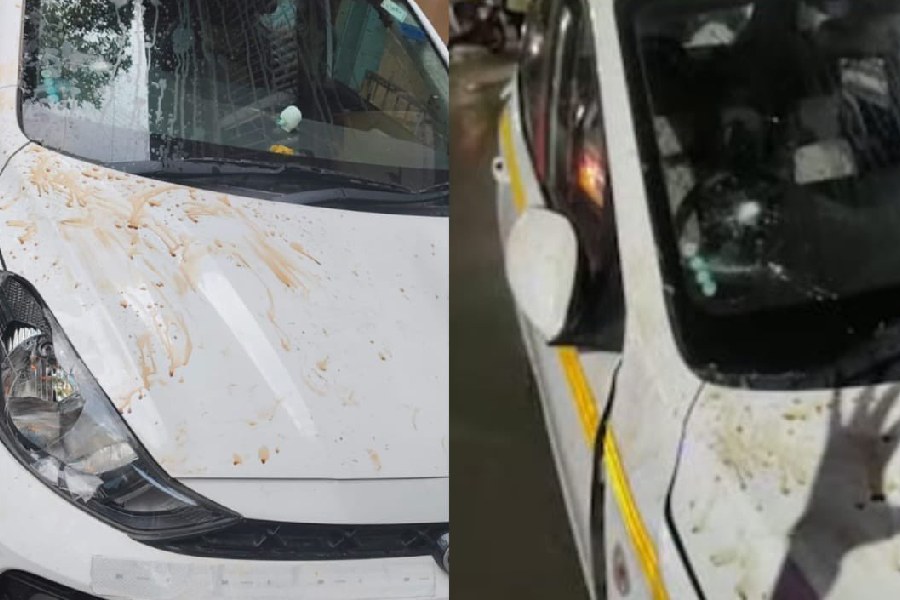 |
| Maksood covers himself as the tiger towers over him after he fell into its enclosure at the Delhi zoo; (below) zoo workers carry Maksood’s body. (PTI/Courtesy AAJ Tak and Reuters) |
 |
New Delhi, Sept. 23: Hands folded and cowering against an 18-foot wall, Maksood begged for his life as Vijay towered over him, their faces just inches apart.
Moments later, the 200kg white tiger pounced and then walked away with Maksood hanging limply from his jaws.
Hundreds of onlookers stood around the moat at the National Zoological Park in central Delhi, watching in horror.
The six-year-old male tiger and the 20-year-old labourer with a history of mental ailment had been sucked into an accidental face-off that was captured on a mobile phone and beamed later in drawing rooms across the country.
Onlookers said Maksood jumped over a knee-high fence and climbed a three-foot concrete wall before leaning into the tree-lined moat to catch a glimpse of the tiger. The fence and the wall together are referred to as “stand-off barrier” by zoo officials.
It is not clear whether he lost his balance or jumped but he dropped 18 feet into the den of the tiger that was lounging around in the island.
“The tiger seemed startled at first when he saw the man drop. It was some distance away. It took some steps towards the man and as the guards and the people threw stones at it to divert its attention, it went back some paces. For some seconds, it was as if the tiger was sizing up his quarry. It went back and forth for some time before lunging at the man’s arm and then finally going for his neck,” said Zalauddin, who had gone to the zoo with his four-year-old son.
In footage shot by an onlooker, Maksood can be seen hanging from the jaws of the 6-foot-long tiger, seemingly trying to shield his head from the beast.
After dragging Maksood’s now-limp body for some minutes, the tiger dropped it in a corner of the moat, before retreating into its enclosure a few feet away. The tiger did not try to feed on the body.
The enclosure, behind a curtain of bamboo trees and foliage, can be closed and the tiger was not seen near the moat later in the afternoon.
PTI quoted Himanshu, an eyewitness who informed police, as saying: “The tiger kept hitting the man with its paws for almost 15 minutes while the man was sitting scared in front of him. The tiger then caught hold of his neck and dragged the man through the whole arena until he was dead.”
Maksood’s body lay there, covered in a white shroud for over two hours. It was later removed in a body bag and taken for post-mortem.
“This happened too quickly for us to take out the tranquilliser guns and disable the tiger. We have taken every precaution that a zoo can take to protect visitors but these kind of freak accidents happen unfortunately,” said Amitabh Agnihotri, the director of the zoo.
“All the enclosures of the National Zoological Park are absolutely safe. No visitor can reach the moat wall of the enclosure without crossing the stand-off barrier. It was impossible for him to have slipped from the wall. He jumped purposefully,” the director added.
Maksood’s father Mehfooz said in a statement to the police that his son was mentally ill and was undergoing treatment for the past four years.
The National Zoological Park, located in the centre of the capital and one of the oldest in the country, is spread over 176 acres and is home to about 1,556 species. The zoo draws 5,000 to 6,000 visitors on weekdays and 12,000 to 13,000 on weekends.
The white tiger, one of the three on the premises, is a star attraction — each eats nearly 10kg of buffalo meat every day during the summer and 12kg in the winter and undergoes a full medical check-up every three months.
Born in 2008 to Lakhshman and Yamuna, Vijay shares its cage with the two others — which are all descendants of Mohan, the original white tiger that was captured from Govindgarh jungle at Rewa in Madhya Pradesh in 1951.
The tigers are let out of their enclosures and into the moat one at a time in rotation for around four hours everyday.
Kartick Satyanaran, co-founder of Wildlife SOS, a non-profit wildlife conservation organisation, said: “The Delhi zoo can clearly not be blamed for this incident. People have to maintain etiquette and use their common sense while at the zoo. Zoos have to be looked at as a place of learning and not some cheap entertainment. This man crossed two barriers to ‘fall or jump’ into the tiger enclosure. We are dealing with an animal that is scared, curious and has no idea about what is happening. For the animal, it is invasion of its territory. Usually, we see this type of accidents happening when a visitor is intoxicated or suicidal or mentally unstable.”
A senior wildlife biologist said the incident should be viewed as similar to a person trying to cross a railway track moments away from an oncoming train.
“Why did he jump the (first) wall and climb onto the moat wall? This should be seen as a clear case of irresponsible behaviour leading to a tragic outcome,” said Ravi Chellam, a conservation biologist at the Foundation for Ecological Security.
CLOSER HOME
December 16, 2000, Alipore Zoo, Calcutta: An apparently drunk man dodges security, clambers over the wire fence of the tiger enclosure, swims across the moat and tries to “entertain” a tiger named Bob. The intruder is mauled to death
January 1, 1996, Alipore Zoo: Two drunk men straight from a New Year’s Eve bash enter tiger Shiva’s enclosure and try to garland him. The terrified tiger kills one and seriously injures the other










